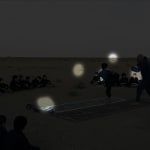
Emmanuel Van der Auwera
Missing Eyes, 2017
HD Video
14 min 21 sec
(Vimeo password: missing)
(Vimeo password: missing)
Edition of 5 plus 1 AP
Further images
'Missing Eyes' is the final work in a trilogy that reflects on the consumption of extreme images. Just as in 'A Certain Amount of Clarity' and 'Central Alberta' it also...
"Missing Eyes" is the final work in a trilogy that reflects on the consumption of extreme images. Just as in "A Certain Amount of Clarity" and "Central Alberta" it also has an obscured image at it's centre, but this time the viewers, too, are absent. The film, which remains nearly pitch-black for it's entirety, is animated only by a swarm of dots that expose fragments of the underlying video, like flashlights scanning the surface of a landscape.
The film is based on fifteen pairs of eyes recorded using eye-tracking recognition software. Volunteers were shown a promotional video by ISIS in which six children enter an abandoned castle to look for and execute hostages in a game of cat and mouse. Each viewer's gaze is a moving dot that allows you to peer through an otherwise darkened screen. We quite literally experience seeing through the eyes of others. The idea was not to show the film they are watching, but rather to obstruct it. It places a veil over images that should not exist, while at the same time asking critical questions about the act of looking and the responsibility it entails.
From "Portraits in Absentia: An Interview with Caroline Dumalin" in Harlan Levey & Amanda Sarroff, "Emmanuel Van der Auwera: A Certain Amount of Clarity", (Brussels: Mercatorfonds, 2020), p.19
The film is based on fifteen pairs of eyes recorded using eye-tracking recognition software. Volunteers were shown a promotional video by ISIS in which six children enter an abandoned castle to look for and execute hostages in a game of cat and mouse. Each viewer's gaze is a moving dot that allows you to peer through an otherwise darkened screen. We quite literally experience seeing through the eyes of others. The idea was not to show the film they are watching, but rather to obstruct it. It places a veil over images that should not exist, while at the same time asking critical questions about the act of looking and the responsibility it entails.
From "Portraits in Absentia: An Interview with Caroline Dumalin" in Harlan Levey & Amanda Sarroff, "Emmanuel Van der Auwera: A Certain Amount of Clarity", (Brussels: Mercatorfonds, 2020), p.19
Exhibitions
ENTER #8: Emmanuel van der Auwera - Blue Water White Death, Mu.ZEE, 2018Publications
Emmanuel Van der Auwera: A Certain Amount of ClarityEdited by Harlan Levey and Amanda Saroff; With contributions by Justine Ludwig, Caroline Dumalin, Hans de Wolf, and Ive Stevenheydens
Published by Mercatorfonds and distributed by Yale University Presspp. 53-61
